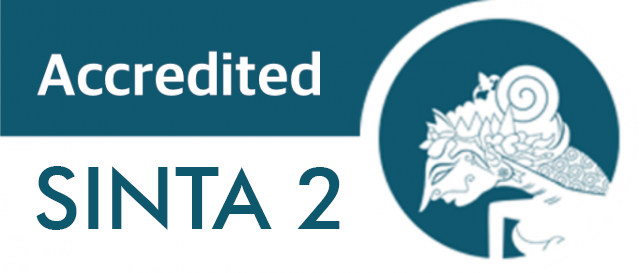Representation Ability in Mathematical Modeling Based on Learning Independence
DOI:
https://doi.org/10.18326/hipotenusa.v6i2.2424Kata Kunci:
mathematical representation, mathematical modeling, learning independence, problem-based learningAbstrak
This research investigates the impact of Problem-Based Learning (PBL) on students’ mathematical representation abilities within the context of mathematical modeling, with a particular focus on the role of learning independence. The research employs a mixed-method sequential explanatory model to analyze the effectiveness of Problem-Based Learning and to categorize students’ abilities and independence levels. Conducted with class XI TL 2 at SMAN 1 Mranggen during the 2023-2024 academic year, the findings reveal that PBL significantly enhances students’ mathematical representation abilities. Moreover, learning independence is identified in two distinct categories–high and medium–which correspond with similar levels of representation ability. Students’ mathematical representation ability has two categories, namely high and medium. These insights underscore the importance of self-directed learning in fostering mathematical comprehension and skills.
Referensi
Abdul Aziz, T., & Kurniasih, M. (2019). External representation flexibility of domain and range of function. Journal on Mathematics Education, 10, 143–156. https://doi.org/10.22342/jme.10.1.5257.143-156
Ahsan, M. G. K., Cahyono, A. N., & Kharisudin, I. (2023). Learning mathematical modelling with digital tools: A systematic literature review. AIP Conference Proceedings, 2614(1), 040082. https://doi.org/10.1063/5.0126587
Al-Tabany, T. I. B. (2017). Mendesain Model Pembelajaran Inovatif, Progresif , dan Kontekstual: Konsep, Landasan, dan Implementasinya pada Kurikulum 2013 (Kurikulum Tematik Integratif/KTI). Jakarta: Prenadamedia Group.
Ang, K. C. (2018). Mathematical Modelling for Teachers: Resources, Pedagogy and Practice. Routledge. https://doi.org/10.4324/9781351247979
Bach, C. C., Bergqvist, E., & Jankvist, U. T. (2024). Students’ dynamic communication while transforming mathematical representations in a dynamic geometry environment. ZDM – Mathematics Education. https://doi.org/10.1007/s11858-024-01575-x
Bandura, A. (1997). Self-efficacy: The exercise of control. New York: W. H. Freeman and Company.
Blum, W. (2002). ICMI Study 14: Applications and modelling in mathematics education – Discussion document. Educational Studies in Mathematics, 51(1), 149–171. https://doi.org/10.1023/A:1022435827400
Blum, W. (2015). Quality Teaching of Mathematical Modelling: What Do We Know, What Can We Do? In S. J. Cho (Ed.), The Proceedings of the 12th International Congress on Mathematical Education (pp. 73–96). Springer International Publishing. https://doi.org/10.1007/978-3-319-12688-3_9
Blum, W., & Leiß, D. (2007). How do Students and Teachers Deal with Modelling Problems? In C. Haines, P. Galbraith, W. Blum, & S. Khan (Eds.), Mathematical Modelling (pp. 222–231). Woodhead Publishing. https://doi.org/10.1533/9780857099419.5.221
Buchholtz, N. (2021). Students’ modelling processes when working with math trails—Processos de modelação de alunos envolvidos em trilhos matemáticos. 30, 140–157. https://doi.org/10.48489/quadrante.23699
Cadapan, R. R., Tindowen, D. J., Mendezabal, M. J., & Quilang, P. (2022). Graduate school students’ self-efficacy toward online learning in the midst of the COVID-19 pandemic. International Journal of Evaluation and Research in Education (IJERE), 11(2), Article 2. https://doi.org/10.11591/ijere.v11i2.21856
Eames, C., Brady, C., Jung, H., Glancy, A., & Lesh, R. (2018). Designing Powerful Environments to Examine and Support Teacher Competencies for Models and Modelling. In R. Borromeo Ferri & W. Blum (Eds.), Lehrerkompetenzen zum Unterrichten mathematischer Modellierung: Konzepte und Transfer (pp. 237–266). Springer Fachmedien. https://doi.org/10.1007/978-3-658-22616-9_11
Falloon, G., Forbes, A., Stevenson, M., Bower, M., & Hatzigianni, M. (2022). STEM in the Making? Investigating STEM Learning in Junior School Makerspaces. Research in Science Education, 52(2), 511–537. https://doi.org/10.1007/s11165-020-09949-3
Goldin, G. A. (2002). Affect, Meta-Affect, and Mathematical Belief Structures. In G. C. Leder, E. Pehkonen, & G. Törner (Eds.), Beliefs: A Hidden Variable in Mathematics Education? (pp. 59–72). Springer Netherlands. https://doi.org/10.1007/0-306-47958-3_4
Greefrath, G., Hertleif, C., & Siller, H.-S. (2018). Mathematical modelling with digital tools—A quantitative study on mathematising with dynamic geometry software. ZDM, 50(1), 233–244. https://doi.org/10.1007/s11858-018-0924-6
Hartmann, L.-M., & Schukajlow, S. (2021). Interest and Emotions While Solving Real-World Problems Inside and Outside the Classroom. In F. K. S. Leung, G. A. Stillman, G. Kaiser, & K. L. Wong (Eds.), Mathematical Modelling Education in East and West (pp. 153–163). Springer International Publishing. https://doi.org/10.1007/978-3-030-66996-6_13
Hasanah, N., Asih, T. S. N., & Kharisudin, I. (2021). Mathematical Problem Solving Skill Viewed from Epistemic Curiosity on Fostering Communities of Learners. Unnes Journal of Mathematics Education Research, 10(A), 134–139.
Hendriana, H., Johanto, T., & Sumarmo, U. (2018). The role of problem-based learning to improve students’ mathematical problem-solving ability and self confidence. Journal on Mathematics Education, 9(2), 291–299. https://doi.org/10.22342/jme.9.2.5394.291-300
Hidayah, L., Sudarman, S. W., & Vahlia, I. (2019). Pengaruh Model Pembelajaran Reciprocal Teaching Terhadap Hasil Belajar Matematika Ditinjau dari Kemandirian Belajar Peserta didik. AKSIOMA: Jurnal Program Studi Pendidikan Matematika, 8(1), Article 1. https://doi.org/10.24127/ajpm.v8i1.1925
Jablonski, S. (2024). Challenges in geometric modelling–A comparison of students’ mathematization with real objects, photos, and 3D models. Eurasia Journal of Mathematics, Science and Technology Education, 20(3), em2414. https://doi.org/10.29333/ejmste/14321
Kharisudin, I., & Cahyati, N. E. (2020). Problem-solving ability using mathematical modeling strategy on model eliciting activities based on mathematics self-concept. 1567(3). Scopus. https://doi.org/10.1088/1742-6596/1567/3/032067
Listiawati, N., Sabon, S. S., Siswantari, Subijanto, Wibowo, S., Zulkardi, & Riyanto, B. (2023). Analysis of implementing Realistic Mathematics Education principles to enhance mathematics competence of slow learner students. Journal on Mathematics Education, 14(4), Article 4. https://doi.org/10.22342/jme.v14i4.pp683-700
Magana, A. J., Arigye, J., Udosen, A., Lyon, J. A., Joshi, P., & Pienaar, E. (2024). Scaffolded team-based computational modeling and simulation projects for promoting representational competence and regulatory skills. International Journal of STEM Education, 11(1), 34. https://doi.org/10.1186/s40594-024-00494-3
Maslihah, S., Waluya, S. B., Rochmad, Kartono, Karomah, N., & Iqbal, K. (2021). Increasing mathematical literacy ability and learning independence through problem-based learning model with realistic mathematic education approach. Journal of Physics: Conference Series, 1918(4), 042123. https://doi.org/10.1088/1742-6596/1918/4/042123
National Council of Teachers of Mathematics. (2000). Principles and Standards for School Mathematics. Reston, VA: NCTM.
National Council of Teachers of Mathematics. (2018). Catalyzing Change in High School Mathematics: Initiating Critical Conversations. Reston, VA: NCTM.
National Council of Teachers of Mathematics. (2020). Standards for the Preparation of Secondary Mathematics Teachers. Reston, VA: NCTM. https://www.nctm.org/uploadedFiles/Standards_and_Positions/NCTM%20CAEP%202020%20HS.pdf
Nurochmah, Y., & Kharisudin, I. (2023). Mathematical Modeling Problem Solving Viewed from Students’ Mathematical Self-Concept on Means-Ends Analysis Based on Blended Learning. Unnes Journal of Mathematics Education, 12(2), Article 2. https://doi.org/10.15294/ujme.v12i2.74003
Nurrahmawati, N., Sa’dijah, C., Sudirman, S., & Muksar, M. (2021). Assessing students’ errors in mathematical translation: From symbolic to verbal and graphic representations. International Journal of Evaluation and Research in Education (IJERE), 10(1), Article 1. https://doi.org/10.11591/ijere.v10i1.20819
Rahman, A. A., & Kharisudin, I. (2019). An Analysis of Problem Solving Ability using mathematical modeling strategies in Brain-Based Learning. Unnes Journal of Mathematics Education, 8(3), Article 3. https://doi.org/10.15294/ujme.v8i3.32218
Riyanto, B., Zulkardi, Z., Indra Putri, R., & Dr, D. (2019). Senior high school mathematics learning through mathematics modeling approach. Journal on Mathematics Education, 10, 425–444. https://doi.org/10.22342/jme.10.3.8746.425-444
Rodriguez-Martinez, L. Y., Hernandez-Martinez, P., & Perez-Martinez, M. G. (2023). Development of a protocol to measure mathematics higher-order thinking skills in Mexican primary schools. Journal on Mathematics Education, 14(4), Article 4. https://doi.org/10.22342/jme.v14i4.pp781-796
Sanjari, A., & Manouchehri, A. (2024). Interactive Learning: Unpacking the Influence of Computer Simulations on Students’ Mathematical Modeling Processes. Education Sciences, 14(4), Article 4. https://doi.org/10.3390/educsci14040397
Sari, N. (2024). Improving Learning Independence of Elementary Students through the Two Stay Two Stray Method. Journal of Childhood Development, 4(1), 145–153. https://doi.org/10.25217/jcd.v4i1.3970
Scheiner, T., & Montes, M. A. (2024). Exploring prospective teachers’ stances in making sense of students’ mathematical ideas. Journal of Mathematics Teacher Education. https://doi.org/10.1007/s10857-024-09639-1
Serpe, A., & Frassia, M. G. (2020). Task Mathematical Modelling Design in a Dynamic Geometry Environment: Archimedean Spiral’s Algorithm (Y. D. Sergeyev & D. E. Kvasov, Eds.; Vol. 11973, pp. 478–491). Springer International Publishing. https://doi.org/10.1007/978-3-030-39081-5_41
Su, K.-D. (2024). The Challenge and Opportunities of STEM Learning Efficacy for Living Technology Through a Transdisciplinary Problem-Based Learning Activity. Journal of Science Education and Technology. https://doi.org/10.1007/s10956-024-10094-z
Sutrisno, H., & Kharisudin, I. (2020). Problem solving ability with mathematical modeling strategy in term of mathematics self-efficacy on Generative Learning Model. Unnes Journal of Mathematics Education, 9(1), Article 1. https://doi.org/10.15294/ujme.v9i1.35674
Villegas, J. L., Castro, E., & Gutiérrez, J. (2009). Representaciones en Resolución de Problemas: Un estudio de caso con problemas de optimización. Electronic Journal of Research in Education Psychology, 7(17), Article 17. https://doi.org/10.25115/ejrep.v7i17.1342
Zulkarnaen, R. (2020). Konsepsi Siswa dalam Proses Pemodelan Matematis. SJME (Supremum Journal of Mathematics Education), 4(2), Article 2. https://doi.org/10.35706/sjme.v4i2.3638
Unduhan
Diterbitkan
Cara Mengutip
Terbitan
Bagian
Lisensi
Hak Cipta (c) 2024 Iqbal Kharisudin, Radika Widiatmaka, Masrukan

Artikel ini berlisensiCreative Commons Attribution-NonCommercial-ShareAlike 4.0 International License.

This work is licensed under a Creative Commons Attribution-ShareAlike 4.0 International License.


